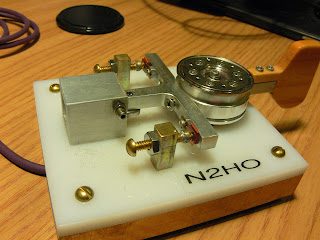In particular I got involved in interesting single-lever paddle design proposed by A. Pershin RV3AE (http://forum.qrz.ru/post747010-2847.html, http://forum.qrz.ru/post747473-2855.html). The main problem of a single lever paddle is "bouncing", and this design not only eliminates possible bouncing, but also provides a definite-feeling center position. Sketches below illustrate the idea which consists of use of a single magnet placed behind the brass "insert" freely suspended in the frame of brass or aluminum alloy. It works as follows.
The insert has a vertical frontal V-shaped groove, across which can roll a small ball bearing placed at the end of the paddle’s lever. Attraction force of the magnet placed behind the insert always holds the ball bearing at the center of the V-shaped groove. When the ball bearing moves across this groove it pushes the insert back increasing the distance between the magnet and the ball bearing, and the magnetic force tends to return it to its former position. Thus, with proper selection of magnetic power, magnet position and the shape of the groove paddle works without "bouncing" which is the major drawback of the single lever paddle, and the center position is definite and positive.
The rectangular insert is freely suspended on the cones (or solid axis) inside of the frame made in my case out of a segment of a square aluminum profile approximately 3/4” long with the internal opening of 1/2” x 1/2” and the wall thickness of 1/8”.
The thickness of the brass insert is chosen to be 1/4” and the width of it is a little smaller (about .004"-.005") than 1/2” opening which allows it freely fit and hang into the internal opening of the frame but without noticeable play. The insert’s vertical size should be about 1/16” shorter than it’s width which allows insert freely hangs and moves inside the frame. The insert should be drilled together with the frame (segment of the aluminum profile) to ensure proper alignment of the holes.
To do this auxiliary hole should be drilled in the front bottom of the center of the profile and this hole should be threaded (say, metric M4 thread size). Then the insert should be firmly clamped inside the frame using the appropriate size screw which threads into this hole. The entire assembly should be drilled then transversely with the drill bit of the diameter of about 1.5mm. A M4 threaded hole at the bottom of the frame is being used later to fasten the whole assembly to the base of the paddle. The holes on both sides of the frame should be reamed to needed diameter and be threaded for cones (for cones I used appropriate size of set screws found in my junk box).
The V-shape groove in the insert is being cut using triangular file to the depth of about 1.5mm, then auxiliary hole (with the diameter of about 1.0-1.5mm) drills through the center of the groove at the bottom of the insert, then from the back of the insert this hole should be reamed to the diameter of cylindrical magnet to the certain depth (not fully through the insert!). The distance from the ball bearing to the magnet and its magnetic power determines proper function of the entire system. V-shaped groove (especially the edges) should be rounded slightly using needle files and polishes with very fine sandpaper. All this is being done during final assembly and adjustment.
The force of magnetic attraction (i.e. the force on the paddle’s lever) can be adjusted if necessary by use of the nonmagnetic washers, being placed under the magnet increasing the distance to the ball bearing. These washers may be made out of a thin plastic or even thick paper (which I actually used). This adjustment procedure looks cumbersome but you do it once (or not often) and it’s not really complicated.
Photo below shows this insert in the assembly separately from the rest of the design, the ball bearing stays in the shown position by the force of attraction of the magnet.
For paddle's lever support I decided to use a motor from the defective computer's hard drive which precisely manufactured and rotates freely on ball bearings without any play. The paddle in the disassembled and assembled views is shown on the photos below. The paddle’s lever consists of three separate parts, T-shaped part with contacts and small ball bearing on the end (it’s diameter in my paddle is about 9mm) is attached to the metal ring (used original ring from the same computer hard drive’s motor), on the opposite side the threaded stud flush to the ring (with LockTite applied) secures the handle.
The lever assembly simply fits over the hard drive’s motor shaft, then an auxiliary ring goes over and whole package gets secured with the motor’s original lid with 6 original screws. This auxiliary ring was taken from another hard drive and it's height selected in a way to make whole package slightly taller than the the motor's shaft (0.5mm or so). For contacts I cannibalized old relay from my junk box with large silver contacts. Contacts on the paddle’s lever are slightly spring loaded (advice of the famous paddles maker RA1AOM), to achieve that very thin piece of the elastic rubber was placed under each contact as seen on the photo below.













1 comment:
Great! I might try making one for myself.
Post a Comment